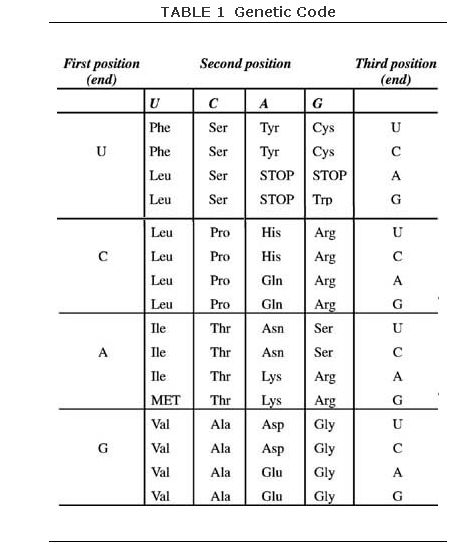RNA Carries Genetic Information
The two strands of DNA contain complementary information, so that one strand of DNA contains the information to specify the other strand. Normally, only one of the two DNA strands is copied to make RNA, in the process called transcription. RNA molecules, in contrast to DNA, are almost always single‐stranded. Base‐pairing determines the sequence of the RNA so that a DNA sequence (3′)ATCCG(5′) is copied into the RNA sequence (5′)UAGGC(3′).
Unlike DNA, RNA is disposable: Many copies of an RNA sequence are made from a single DNA sequence. These copies are used and recycled back to their constituent nucleotides. This allows the cell to respond quickly to changing conditions by transcribing different sequences into RNA. Special sequences called promoters tell RNA polymerase, the enzyme responsible for transcription, where to start making RNA (Figure 1 ).

Figure 1
Proteins are linear polymers of amino acids. The sequence of a protein's constituent amino acids determines its biochemical function. The mRNA sequence is read in groups of three, called codons. Because there are four bases in DNA or RNA, there are 64 (4 3) codons. Only 20 amino acids are specified by translation, so there is more than one codon per amino acid. In other words, the genetic code is redundant. The code also contains punctuation marks. Three codons, UAG, UAA, and UGA, specify stop signals (like the periods in a sentence). One amino acid, methionine, coded by AUG, is used to initiate each protein (like a capital letter at the beginning of a sentence). Just as a letter that starts a sentence can also appear in an uncapitalized form inside the sentence, so methionine also appears internally in proteins. See Table 1

Almost all organisms use the same genetic code. There are some differences, due primarily to the overall base composition of an organism's DNA. For example, Mycoplasma bacterial DNA is very high in A + T. Consequently, the TGG sequence (corresponding to the UGG codon) is rare, and the UGA codon specifies the amino acid tryptophan rather than a stop signal.
The abbreviations for the amino acids are: phe, phenylalanine; leu, leucine; ile, isoleucine; met, methionine; val, valine; ser, serine; pro, proline; thr, threonine; ala, alanine; tyr, tyrosine; his, histidine; gln, glutamine; asn, asparagine; lys, lysine; asp, aspartic acid; glu, glutamic acid; cys, cysteine; trp, tryptophan; arg, arginine; gly, glycine.
Transfer RNA
Transfer RNA (tRNA) is the adaptor between mRNA and protein information. tRNA provides the specificity for the genetic code, so each codon doesn't have to specify a particular amino acid. Transfer RNA contains two active sites.
- The anticodon consists of three nucleotides that form base‐pairs with the three nucleotides of a codon.
- The acceptor end is esterified to the amino acid specified by the codon.
The amino acid is loaded onto the acceptor end by an aminoacyl–tRNA synthetase enzyme (see Figure 2 ).

Figure 2
Ribosomes and translation
Ribosomes are large particles composed of about two‐thirds RNA and one‐third protein by weight. Ribosomes facilitate several reactions:
- Initiation of the synthesis of a protein
- Base‐pairing between the codon in mRNA and the anticodon in tRNA
- Synthesis of the peptide bond
- Movement of the mRNA along the ribosome
- Release of the completed protein from the translation machinery
Ribosomes consist of two subunits: a small subunit primarily involved with initiation, codon‐anticodon interaction, and protein release; and a large subunit primarily concerned with the actual synthetic process:
